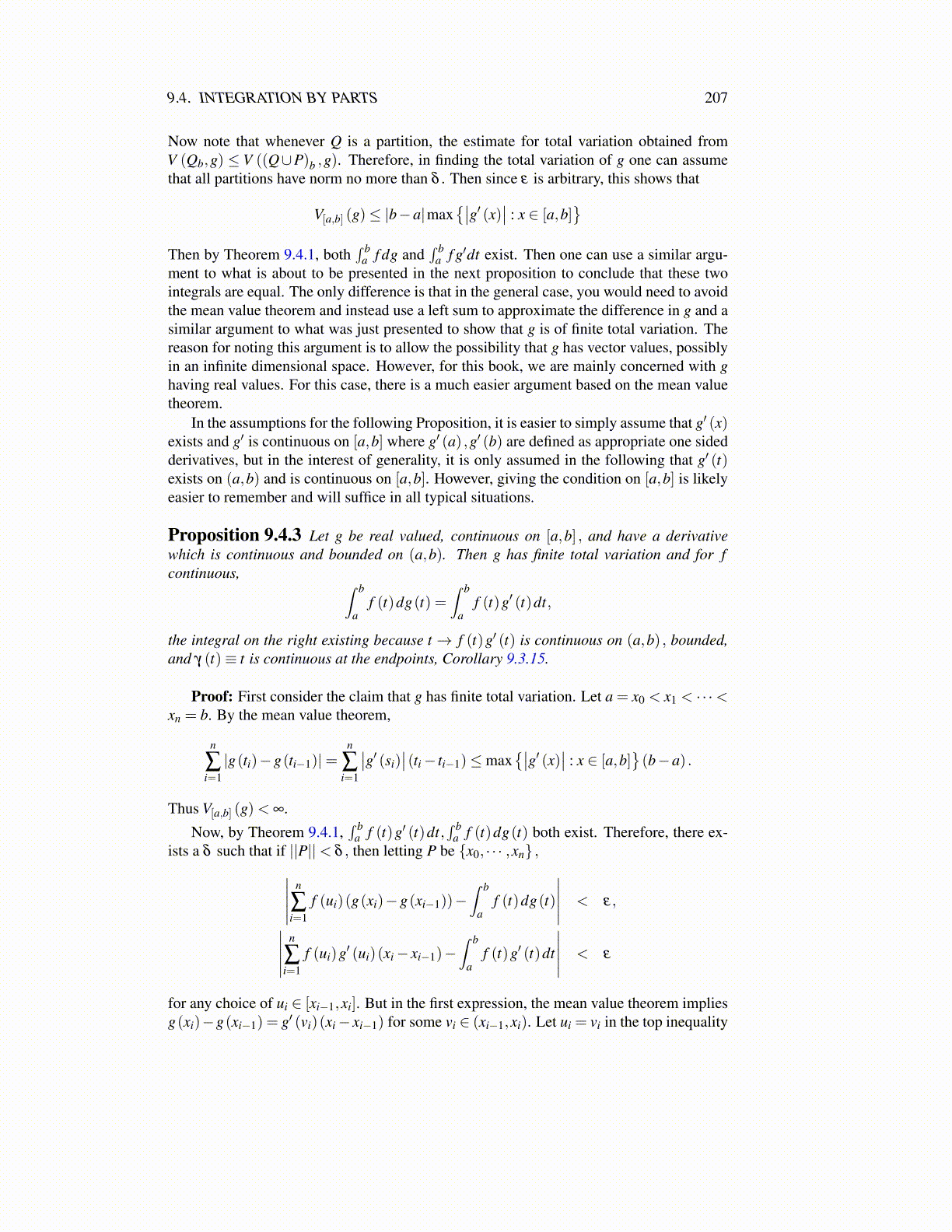
9.5. THE FUNDAMENTAL THEOREM OF CALCULUS 207
Note that this did not explicitly require f to be continuous, just Riemann integrable.In case f is continuous or piecewise continuous, this shows the integral discussed here isthe same as the integral of Definition 9.1.3 because, as shown in Proposition 9.1.5 bothcan be computed by using an antiderivative. If
∫̂is the earlier 1700’s integral and if f is
piecewise continuous with exceptional points between a and b, α0,α1, ...,αn, and f = fion (α i−1,α i) , then ∫̂ b
af dx≡
n
∑i=1
∫̂ α i
α i−1
fidx =n
∑i=1
∫α i
α i−1
fidx =∫ b
af dx.
Definition 9.5.3 When everything makes sense,∫ b
a f (t)dg(t)≡−∫ a
b f (t)dg(t)
This also shows the well known change of variables formula.
Theorem 9.5.4 Suppose F ′ (y) = f (y) for y between φ (a) and φ (b) and f , φ′ are
continuous. Then ∫φ(b)
φ(a)f (y)dy =
∫ b
af (φ (t))φ
′ (t)dt
Proof: This is true because both sides reduce to F (φ (b))−F (φ (a)) .The other form of the fundamental theorem of calculus is also obtained. Note that in
case of the Riemann integral if f ≥ 0, and a≤ b, then∫ b
a f (t)dt ≥ 0. Therefore, assumingf is continuous, ∫ b
a(| f (t)|− f (t))dt ≥ 0,
∫ b
a(| f (t)|+ f (t))dt ≥ 0
and so∫ b
a | f (t)|dt ≥∫ b
a f (t)dt,∫ b
a | f (t)|dt ≥ −∫ b
a f (t)dt which implies∫ b
a | f (t)|dt ≥∣∣∣∫ ba f (t)dt
∣∣∣. This also follows from Theorem 9.3.6.
Theorem 9.5.5 Let f be continuous on [a,b] and suppose V[a,b] (g) < ∞. Then f ∈R([a,x] ,g) for all x ∈ [a,b]. If g(t) = t, then for F (x) =
∫ xa f (t)dt, it follows that F ′ (t) =
f (t) for t ∈ (a,b).
Proof: The first part is obvious because V[a,x] (g)≤V[a,b] (g)< ∞ and so f ∈ R([a,x] ,g)by Theorem 9.3.7. It remains to verify the last part. Let t ∈ (a,b) and let |h| be smallenough that everything of interest is in [a,b]. First suppose h > 0. Then∣∣∣∣F (t +h)−F (t)
h− f (t)
∣∣∣∣= ∣∣∣∣1h∫ t+h
tf (s)ds− 1
h
∫ t+h
tf (t)ds
∣∣∣∣≤ 1
h
∫ t+h
t| f (s)− f (t)|ds≤ 1
h
∫ t+h
tεds = ε
provided that ε is small enough due to continuity of f at t. A similar inequality is ob-tained if h < 0 except in the argument, you will have t + h < t so you have to switchthe order of integration in going to the second line and replace 1/h with 1/(−h). Thuslimh→0
F(t+h)−F(t)h = f (t).
An examination of the proof along with Corollary 9.3.15 yields the following corollary.
Corollary 9.5.6 Let f be continuous on [a,b] except for finitely many points. ThenF (x)≡
∫ xa f dx exists for all x ∈ [a,b]. F ′ (x) = f (x) for x any point in (a,b) at which f is
continuous.